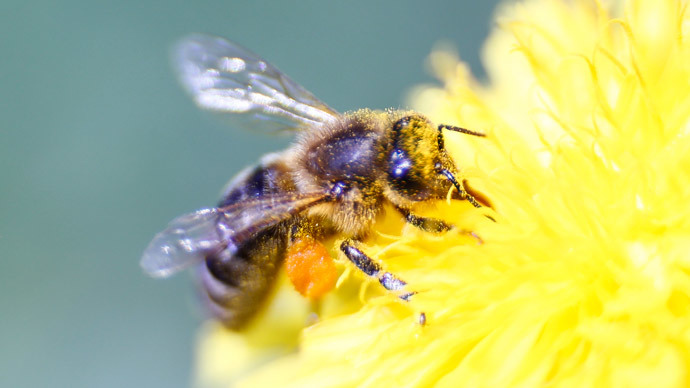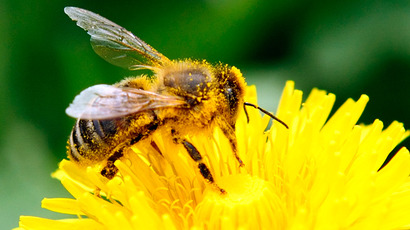Insecticides cause honeybee colony collapse, study shows

Scientists are closer to pinpointing the cause of Colony Collapse Disorder (CCD), the disease killing off honeybees and threatening pollination of the world’s crops. Their research is blaming two popular insecticides.
Researchers at Harvard University’s School of Public Health looked at the effect of two neonicotinoid insecticides on 18 colonies in central Massachusetts. They divided the colonies into three groups: an untreated control group, a group treated with imidacloprid and a group treated with clothianidin. It was a continuation of 2012 research by the same group that showed that “sub-lethal exposure of imidacloprid and clothianidin affected the winterization of healthy honey bee colonies that subsequently leads to CCD,” the study says.
Honeybee hives are generally inactive during the winter, when the colony survives by creating a winter cluster. The bees bundle together for warmth, which self-regulates the internal temperature in the cluster’s center, according to the Back Yard Beekeepers Association. Because of this cycle of inactivity, researchers focused on how well the 18 colonies rebounded from their winter cluster.
“We found honey bee colonies in both control and neonicotinoid-treated groups progressed almost identically, and observed no acute morbidity or mortality in either group until the arrival of winter,” the study said. “As temperatures began to decrease in late October 2012, we observed a steady decrease of bee cluster size in both control and neonicotinoid-treated colonies. While such decline was quickly reversed in the control colonies in January 2013, the neonicotinoid-treated hives continued to decline.”
The study found that the majority of bees in all of the insecticide-treated colonies, regardless of whether they survived or not, had abandoned their hives during the winter. Half of the colonies were lost. The remaining colonies were very small and either without queen bees or had no brood of new bees. But in the control group, the opposite was true. Of the six original groups, five survived. Instead of abandoning the hives, they were quickly repopulated.
The researchers said the results of the second study replicated the results of the 2012 study, and “reinforce the conclusion that sub-lethal exposure to neonicotinoids is likely the main culprit for the occurrence of CCD.”
CCD has killed tens of millions of honeybees in the US, with annual death rates of about 30 percent. Since 2006, about 10 million beehives at an average value of $200 each have been lost, according to a 2013 US Department of Agriculture Study. Honeybees pollinate more than 100 US crops, including apples, zucchinis, avocados and plums, that are worth more than $200 billion a year. CCD is threatening the existence of those crops.
“Currently, the survivorship of honey bee colonies is too low for us to be confident in our ability to meet the pollination demands of US agricultural crops,” the USDA report stated.
“We are one poor weather event or high winter bee loss away from a pollination disaster,” Jeff Pettis, the USDA’s bee research leader, said in the report.
The European Commission adopted a two-year moratorium on the use of three neonicotinoid pesticides - including the two used in the Harvard study - in 2013. Scientists are using the two years to determine whether the ban helps stop declines in bee populations, after which the restriction may be reviewed. US officials have stated that they don’t have enough evidence to ban neonicotinoids.
“Although we have demonstrated the validity of the association between neonicotinoids and CCD in this study, future research could help elucidate the biological mechanism that is responsible for linking sub-lethal neonicotinoid exposures to CCD,” lead author Chensheng (Alex) Lu, associate professor of environmental exposure biology at HSPH, said in the news release. “Hopefully we can reverse the continuing trend of honey bee loss.”













